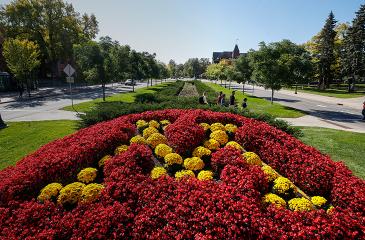Barry Kudrowitz, PhD, director of product design shares how collaboration with diverse fields can help us think outside the box.
Barry Kudrowitz grew up in south Florida. He went to Disney World often and dreamed of becoming an Imagineer— a creative engineer that designs and builds for Disney. Since then, Kudrowitz has co-designed a Nerf toy for Hasbro, an elevator simulator that is in operation at the International Spy Museum in Washington, D.C., and a ketchup-dispensing robot that was featured on the Martha Stewart Show and Conan.
Kudrowitz is an associate professor of product design in the College of Design and also the associate editor of the Journal of Food Design. He received his PhD in mechanical engineering from the Massachusetts Institute of Technology (MIT), studying humor, creativity, and idea generation. Kudrowitz is interested in how creativity is perceived, evaluated and learned. He has years of experience working with the toy industry and has taught toy design for over a decade. He has given numerous talks nationally and internationally on creativity and play.
“At the heart of creativity is novelty— something that is new and different than what exists already. Another element is relevance,” says Kudrowitz. “Creativity is how society moves forward, how things improve, change, and the quality of life gets better. If we’re not creating new things, we’re stuck in the past and doing things the way we’ve always done.”
CREATIVE SOLUTIONS TO LIFE’S PROBLEMS
The strong medical community drew him to Minnesota in 2011. He saw a grand opportunity to develop a relevant product design program that would feed into the large companies here.
“There’s an opportunity to grow the design field toward the medical and health care industry. The University of Minnesota has a design college and six health sciences schools. That’s a very unique situation we should be taking advantage of,” said Kudrowitz. “There are lots of degrees, programs, and experts in all different fields here. We should be reaching out to each other.”
He had an idea to create a Davinci-like degree, where students learn a core subject resembling industrial design, while also taking engineering courses, business entrepreneurship, marketing classes, and anthropology. The goal was to create a well-rounded product designer.
The product design program at the College of Design brings that vision to reality, with curriculum encompassing everything from engineering, business, to humanities. It is truly interdisciplinary, hands on, and focused on a community of practice.
“Innovation comes from crossing disciplines.” – Barry Kudrowitz, PhD
Kudrowitz is a firm believer in finding connections between seemingly unrelated things, such as the connection between improv comedy and creativity. He discovered that the training improv comedians receive—things like deferring judgment, coming up with lots of ideas and building on them—is great practice for team-based idea generation.
If you visit the 3M innovation center for example, there’s a legend about how they came up with their facemasks. 3M was trying to make a non-woven bra when someone was toying around with the material by putting it over their face, and voilà, we have the ubiquitous disposable dust masks we see worn by doctors, construction workers, and people fearing a cold.
The underlying connection between humor and creativity illustrates how bringing unexpected things together can lead to innovation.
A PROCESS FOR EMPATHY
Design is more than making things look pretty. It’s a methodology for solving problems.
Kudrowitz explains, “Design is about addressing problems that you have in the world that have real constraints and using creative methods and processes to solve them.”
Design is about creating things for other people—and empathy plays a big part in this.
“When you prototype a concept, you bring them to the user to see what they will do with it. You find out what they like or don’t like and make changes, that’s part of design process. The user is in the center.”
The College of Design uses different tools and techniques to teach students to empathize with users and get into their mindsets, sometimes borrowing ethnographic research methods from anthropology. This includes going out to talk with people who will be engaging with their designs. Oftentimes, this means speaking with people who are very different from the designer themselves.
“It takes practice. Designers have to balance what they think is good with what the user wants,” explains Kudrowitz. “The end goal is to get something into someone’s hands that changes their life for the better. Empathy is at the heart of that.”
“Reimagine Health” is a series covering remarkable individuals making a difference in health and health care. Through novel approaches and interprofessional collaboration, the Office of Academic Clinical Affairs is reimagining health for Minnesota and beyond. Together we can address complex problems affecting community and individual health.



